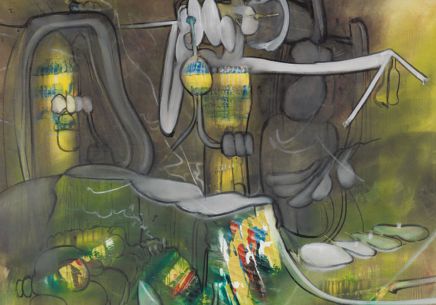
In the Main Building of the National Museum in Krakow we've shown paintings of one of the most important artists of the 20th century, the last of the great surrealists, the artist who influenced not only American abstract expressionism, but also postwar art in Poland.
“Continuing the cycle of exhibitions devoted to greatest world artists, the National Museum in Krakow invites you today to become acquainted with works by one of the ‘most significant creators of the 20th century,’ writes Marga Paz, the curator of the exhibition. After presentations of works by artists such as Andy Warhol, Marc Chagall, Salvador Dali, William Turner, Alexander Rodchenko, Antonio Tàpies, our audience will have an opportunity to get to know the great surrealist Roberto Matta.
His works influenced many artists, including the outstanding Polish artist Tadeusz Kantor, who was fascinated with Matta at the end of the 1940s and at the beginning of the 1950s, which was reflected in his paintings and drawings from the “metaphorical” period. Alfred Lenica, another painter associated with the Krakow Group, whose exhibition we are presenting simultaneously in the hall of the Main Building, had close artistic relations with Matta, too,” writes Zofia Gołubiew, Director of NMK, in the introduction to the publication accompanying the exhibition.
Roberto Matta was an architect, sculptor, drawing artist, interior designer and poet, but his most favourite activity was painting; at the exhibition Roberto Matta. Man and Universe we present 25 paintings, mainly large-format ones, borrowed from various sources, including the collection of the artist’s family and a few European museums.
“I think that through paintings I have created a world for myself, something like the Universe, with a ritual in whose centre I am completely alone, like Robinson Crusoe,” said the artist.
He was born in Santiago de Chile, where he attended the Jesuits’ School of the Holiest Hearts of Jesus and Mary; then he studied architecture and in 1933 he left for Europe, through which he travelled extensively. In Paris he worked in Le Corbusier’s atelier and on the design of a Spanish pavilion for the World Exhibition in 1937, where he met Picasso, Miró, Magritte, Caldero and Dali. Upon the invitation of André Breton, the „pope of surrealism”, he started to publish articles in the “Minotaure” journal and took part in the famous International Exhibition of Surrealists in 1938.
Surrealism, one of the most important trends in the art of the 20th century, was created on the ground prepared by dadaism, which was an attitude and protest against reality rather than a trend. Dadaists created a rebellious and iconoclastic art that negated the past and emphasised the role of chance and gesture. They assigned the status of art to lower-rank reality; they decided what a work of art is and what is not. André Breton, the author of the famous Manifesto presenting the aspects and possibilities of surrealism, was also a member of the dadaists’ movement before writing the Manifesto. He wrote, among others, that surrealism is “psychic automatism in its pure state, by which one proposes to express – verbally, by means of the written word, or in any other manner – the actual functioning of thought. Dictated by the thought, in the absence of any control exercised by reason…”. Automatic writing became one of surrealists’ methods and was well known to Matta, who also contributed to the development of this trend. His Psychological morphologies – a cycle of paintings from the 1930s that constituted a sort of mental landscapes referring to human mental life and states of human mind, such as desire, despair or melancholy – aroused admiration among members of the group. André Breton said: “Matta was in possession of a completely new palette of colours ..., maybe it was the only one of this kind, and certainly the most fascinating one since Matisse’s times.”
In times when Matta belonged to surrealists, his friendship with Marcel Duchamp began. “Matta is the most perceptive painter of his generation,’ Duchamp said.
In 1939 Matta moved to New York, where he aroused interest among painters of the “New York school”, such as Robert Motherwell, Jackson Pollock, William Baziotes or Arshile Gorky, and exerted a decisive influence on the development of American abstract expressionism. “If you ask me which artist is in the centre of attention in New York at the moment, I’ll answer that it’s Matta,” wrote the editor of the View magazine in 1943.
In 1948 Matta abandoned abstraction. He returned to Europe, lived in Rome and travelled much. He was a socially engaged artist: he travelled to Cuba, visited Arabian countries in 1970, where he met representatives of artistic and intellectual circles, and created paintings for the People’s Movement for the Liberation of Angola. In 1972, upon the invitation of President Allende, he returned to Chile, where he took part in the collective creation of murals. He died in his house in Tarquinia in Italy. The exhibition in NMK encompasses Matta’s works from various periods: from the early 1950s, when he filled his paintings with disturbing anthropomorphic figures expressing fear and violence, through a cycle of large-format paintings from the 1960s - El Proscrito deslubrante (The blinding exile), where the title ‘exile’ was to serve as Matta’s artistic alter ego till the last works. In the 1970s Matta was fascinated with the world of science and nature and sought ways to express diverse and complex existential states of a human being. In the middle of the 1980s, “cosmic” motifs started to prevail, reflecting the artist’s interest in the Universe.
prepared by: Katarzyna Bik
Curator: Marga Paz
Coordinator: Beata Foremna
Matta, Main Building, exhibition, surrealism, museum krakow, Poland
MNK The Main Building
al. 3 Maja 1- Monday: closed
- Tuesday - Sunday: 10.00-18.00